Western Digital Caviar Green 3TB and My Book Essential 3TB Drives Reviewed
by Anand Lal Shimpi on October 19, 2010 1:43 PM EST- Posted in
- Storage
- HDDs
- Western Digital
- 3TB
Let’s Go Outside: My Book Essential
Western Digital also sent along the My Book Essential, an external version of the 3TB Caviar Green. Unlike Seagate’s GoFlex Desk, the My Book Essential doesn’t have an option for interfaces: USB 3.0 is all you get. Obviously USB 3.0 is backwards compatible with USB 2.0 on the host connector side.
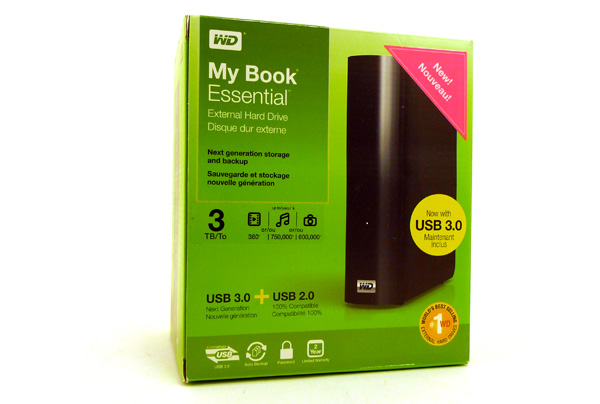
The first thing I wanted to test with the My Book Essential was how well it kept the drive cool. Remember the Caviar Green is a 4 platter sub-6000 RPM drive compared to the 5-platter 7200 RPM design in the GoFlex Desk, so temperatures should inherently be lower. To make sure the drive never gets too hot Western Digital has a grate that runs along the top, spine and bottom of the My Book Essential. A pair of rubber feet prop the drive up a few millimeters off of the ground to allow air in from below.The ventilation story is a lot better than what I encountered with the GoFlex Desk.
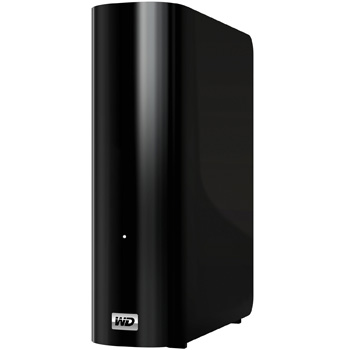
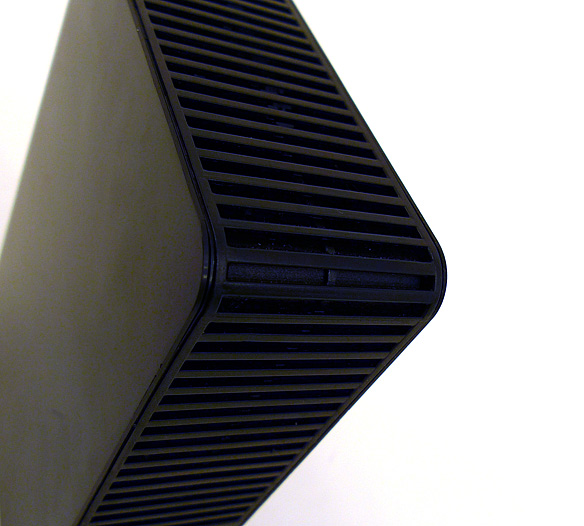
As a result, temperature is a non-issue. Here’s the drive at idle and after over an hour of use:
| Thermal/Power Comparison | |||||
| Idle | Load | Power Consumption (Idle/Load) | |||
| Western Digital My Book Essential 3TB | 34C | 49C | 5.30W / 9.60W | ||
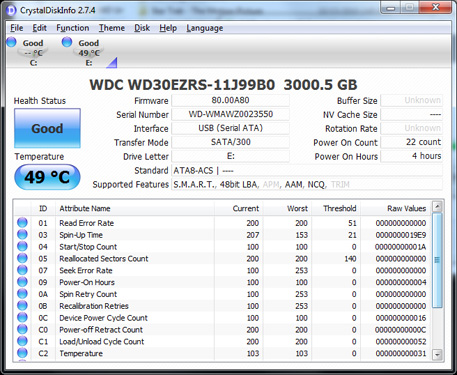
Like Seagate, Western Digital supplies software with the drive to manage the drive and backups. Western Digital doesn’t bundle a NTFS Mac driver so you’ll need to reformat the NTFS formatted drive for write use on a Mac (or supply your own NTFS driver for OS X).
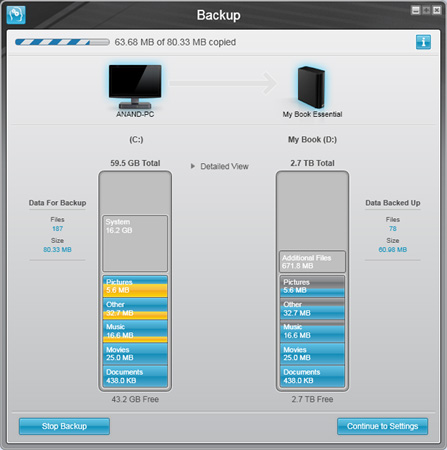
WD’s SmartWare utility does let you seamlessly lock and unlock the drive across both Windows and OS X however.

The performance of the My Book Essential isn’t nearly as good as what we saw with the GoFlex Desk. Seagate is over 25% faster for sequential reads and writes over USB 3.0. I’d say the tradeoff is worth it given the tremendous difference in heat however.
| External 3TB Performance Comparison | |||||
| Seagate GoFlex Desk 3TB (USB 3.0) | Western Digital My Book Essential 3TB (USB 3.0) | Western Digital My Book Essential 3TB (USB 2.0) | |||
| Sequential Read | 151.9 MB/s | 120.6 MB/s | 37.8 MB/s | ||
| Sequential Write | 151.2 MB/s | 119.7 MB/s | 32.9 MB/s | ||
| Random Read | 0.30 MB/s | 0.18 MB/s | 0.17 MB/s | ||
| Random Write | 0.93 MB/s | 0.84 MB/s | 0.82 MB/s | ||
USB 3.0 continues to be a great interface for external storage. There’s very little sequential performance difference between the 3TB My Book Essential and the desktop Caviar Green. Random performance is significantly lower, presumably because of the translation that happens at the USB controller level. As an external drive, you’re more likely to be writing to the My Book Essential sequentially rather than throwing a more random workload at it.


The only problem I had in testing the My Book Essential was very erratic read performance at the beginning of my testing. Here’s a shot of the first sequential read pass on the drive:
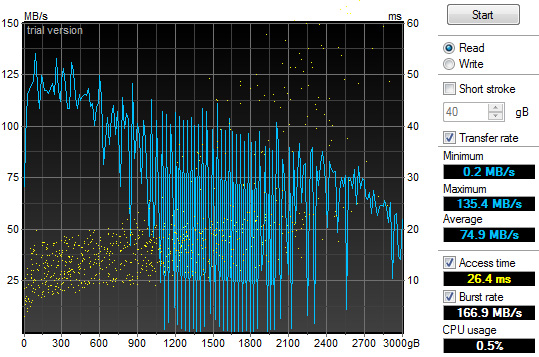
The problem mostly resolved itself after further passes, although there were always some strange performance blips aross various LBAs:
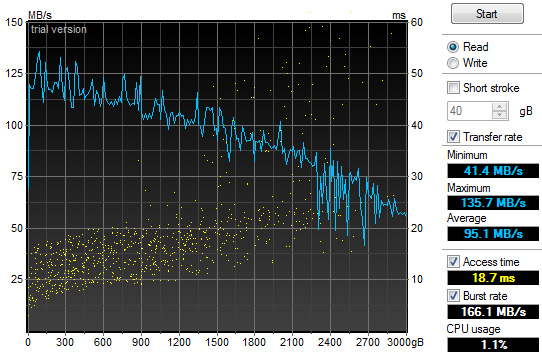
Write performance is also impacted:
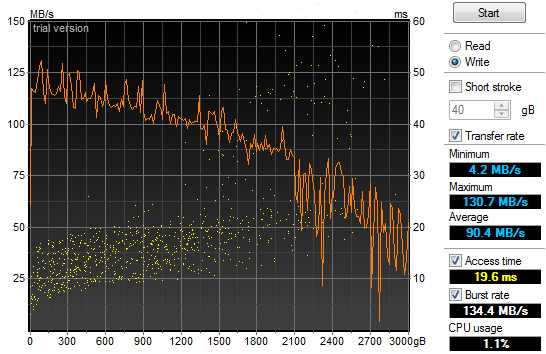
You'll notice that I didn't see these problems with the internal drive, which leads me to believe that this is either a problem with my review sample or with the USB 3 to SATA bridge in the My Book Essential itself. The variable performance also isn't consistent between runs or benchmarks

The move to USB 3 adds about a 3+ ms latency penalty compared to the internal drive. This is ok for backups and large file storage, but it's not something you'd want to use as an application drive.










48 Comments
View All Comments
pvdw - Wednesday, October 20, 2010 - link
I use Linux MD RAID 10 (near-copies) on my home "server". For those who don't know, this is a non-standard RAID level that simulates RAID-10 using only two drives. In addition to redundancy this provides read speed improvements and some write speed improvement. I've set up automatic backups to protect from user error; and use Linux, so no viruses (yet). So I'm protected from all but fire/theft/bomb/hurricane/etc. For this I have off-site storage that syncs on a less frequent basis.Since we've had a number of power cuts here recently, the RAID setup also gives extra security.
Also, I don't know where you get your data from. None of my customers have lost data due to malware (I recover data from systems riddled with them), theft, or fire, but they have due to disk failure. I would put user error at the top of the list. I can see theft moving up the list due to the increase in portable data storage (tablets, smartphones, etc.)
daneren2005 - Wednesday, November 23, 2011 - link
You must be kidding me. Although it happens, not a single person I know has ever had a fire in their house. House break ins once again happen, but are not every day occurrences. I haven't heard of a widespread wipe virus since the early XP days. And when it comes right down to it, the common backup method (external HDD) prevents NONE of these things either. For 99.9% of the population, a RAID 1 provides IDENTICAL protection as an external backup drive. Especially since most consumer backups delete files that were deleted on the main drive, anything but a immediately noticed user error/virus wipe (and usually getting it out of the trash is going to be enough for these cases) would be propagated to the external drive as well.Now I both backup (update ~once a moth and store at brothers house) and RAID my data, but I do both because neither is enough by itself, but RAID isn't any less of a backup option then external backups.
CharonPDX - Tuesday, October 19, 2010 - link
I've had Intel Desktop boards for a few years that support EFI boot. I installed Windows 7 this way onto a 3 TB Intel chipset RAID a while ago, no problem. (Boot to the EFI installer on the Windows 7 disc, rather than the BIOS installer.)TSnor - Tuesday, October 19, 2010 - link
re: "Simply look at worst case seek time and you’ll get an idea for how quickly the platters are spinning" Worse case seek time should be the time it takes the heads to move from one extreme to another. While there might be a correlation between seek time and RPM, it would be because high performance drives tend to maximize both and green drives accept compromises on both.re: "Random performance is significantly lower, presumably because of the translation that happens at the USB controller level. " No, reading random 4K records is much harder for disk drives than reading sequential data. The R/W heads need to get positioned to the correct track between each random IO operation (that's the 'seek time' above) and the correct data has to rotate under the R/W heads (that's rotational latency effected by drive RPM). Reading sequential data the disk drive just reads each record as it comes under the R/W head, with a 1 cylinder (very short) seek to get to the next cylinder. This is why rotating disks can compete with SSDs for sequential data but get crushed on random data.
dertechie - Tuesday, October 19, 2010 - link
He's comparing the 4K reads of the external drive to the 4K reads of internal and other HDDs, not to sequential reads. If you actually look, you'll note that the drive lost over half of its random 4K read performance when using it over USB3 (0.18 MB/s) compared to the numbers it posts as an internal drive (0.40 MB/s). Write performance also dropped compared to internal, but not as much.TSnor - Tuesday, October 19, 2010 - link
re: "If you actually look..." ok. I agree with you.Sufo - Wednesday, October 20, 2010 - link
um, pretty sure he was comparing the internal drive to the external one here (so essentially sata to usb 3). I would be surprised if Anand had forgotten that random reads/writes are slow work on mechanical drives - it's not been that long since he published the last round of articles on the subject...Sufo - Wednesday, October 20, 2010 - link
oops sorry, didn't check next page >_<Dainas - Tuesday, October 19, 2010 - link
Anand,Can you please do some reviews on Samsung's Spinpoints? Only asking because Western Digital and Seagate always seem to have this or that issue with their +1TB drive. Also from what I've seen Samsungs efforts are also consistently faster and more reliable. Would be nice to know what you think of them.
musicman1352000 - Tuesday, October 19, 2010 - link
Yes please!Also, what happened to the noise figures?